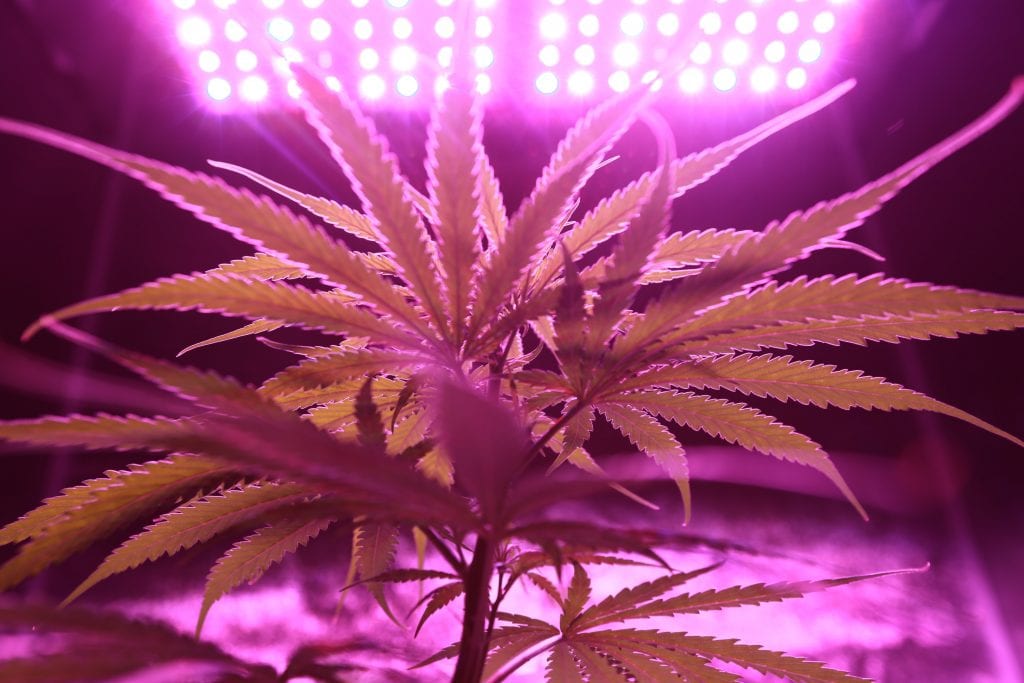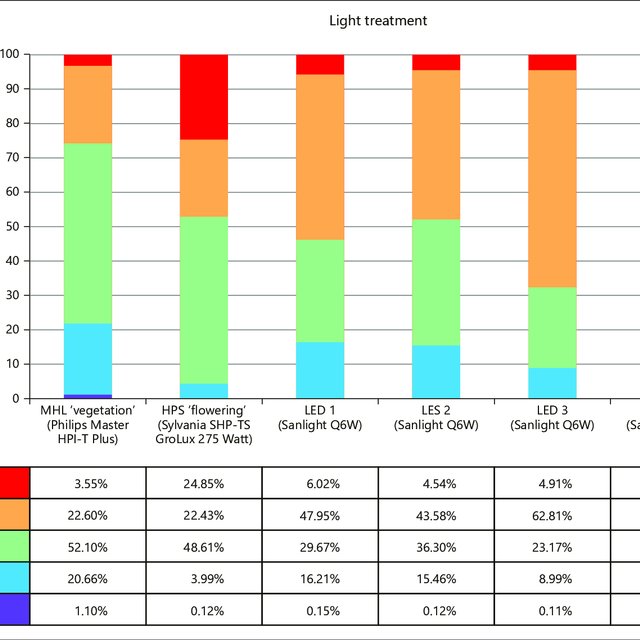By supplying plants with light from different regions of the color spectrum, growers can manipulate the formation of flowers and boost the size of their buds. How different light wavelengths affect cannabinoid production, however, is something that is only now beginning to be explored.

Light Wavelengths And Plant Growth
Before we get stuck into cannabinoids, it’s important to clear up a few basics regarding light wavelengths and cannabis.
Visible light is just one part of the electromagnetic spectrum, which includes the full range of radiation emitted by the sun. Gamma rays, X-rays and radio waves also feature on this spectrum, although these are of no concern to cannabis growers. The visible part of the spectrum itself is also split into different colours, each of which has its own wavelength. Blue light, for instance, has short wavelengths of between 380 and 490 nanometres, while red light has the longest wavelengths of 620 to 750 nanometres.
Cannabinoids aside, these different wavelengths can have a pretty major effect on the growth of cannabis plants. In the summer, for instance, the high angle of the sun ensures that lots of blue light reaches the ground, which plants detect using receptors called cryptochromes. As the sun sets, though, red light predominates, and activates a different type of receptor called phytochromes. In this way, plants are able to recognize when the days begin to get shorter, signaling the start of autumn. For cannabis, this is the cue to begin flowering.
More advanced growers often take advantage of this by supplying their plants with different wavelengths of light during different phases of the growth cycle. Specifically, by using more blue light during the vegetative stage and more red light during flowering, it is possible to maximize bud production while keeping plants relatively compact.
That said, many cultivators simply use a single light source that contains the full range of visible wavelengths throughout their growth cycle, without worrying about switching from blue to red.
Light Wavelengths And Cannabinoids

While the impact of different light wavelengths on plant growth is fairly well established, their effect on cannabinoid production is still rather unclear.
Back in the 1980s, the first proper study on the subject found no difference in THC content between plants that had been grown under normal daylight, or daylight that had been filtered red or blue. However, plants grown under green light filters produced much less THC, probably because green light isn’t absorbed by plants.
As far as scientific research goes, that was about it until a new study finally emerged in 2018. The authors of this paper grew clones of a single cannabis plant under three different light sources, each of which emitted a specific range of frequencies.
Results showed that THC, CBD and CBG production were all highest in plants that were grown under a light that was rich in short wavelengths – thereby consisting of more blue and ultraviolet – and lowest in those that received light with longer wavelengths, containing more red. Interestingly, studies have also indicated that short wavelengths can activate genes that control the production of flavonoids and anthocyanins, both of which contribute significantly to the flavour of cannabis.
It’s important to note, however, that this finding doesn’t count as proof that blue light always leads to more cannabinoids than red light. Rather, it simply confirms that light wavelength does appear to have some affect on cannabinoid production.
Another study, published in 2020, found that pink light increased production of CBD – but not THC – in Hemp. Grown specifically for fiber, the cultivar used in this experiment was genetically predisposed to contain virtually no THC, so it’s perhaps unsurprising that it couldn’t be coaxed into producing more of this cannabinoid.
That said, it is significant that CBD levels were so susceptible to manipulation. By using a light source consisting of a mix of 78 percent red and 17 percent blue light, the researchers were able to triple the concentration of CBD in their plants.
Taken together, these studies suggest that the effect of light wavelengths on cannabinoid production is not straightforward, and may differ between cultivars.
What About Ultraviolet Light?
There is a theory that ultraviolet light causes cannabis to ramp up its cannabinoid production, although the jury is still out on this one. Ultraviolet light has a wavelength that is shorter than that of blue light, and is therefore invisible to the human eye.
Regardless, anyone who has spent too long in the sun will be more than aware of its presence, as it is responsible for the tanning and burning of our skin. By way of protection, our bodies produce a compound called melanin, which acts as a kind of natural sun block. According to popular belief, cannabinoids play a similar role in cannabis plants, hence the assumption that they are produced in greater quantities when ultraviolet light is detected.
A study conducted in 1987 found that ultraviolet light did indeed increase the concentration of THC in some cultivars, but had no impact on other cannabinoids. However, very little proper research has been carried out since then, making it impossible to say for sure how ultraviolet light affects cannabinoid production in cannabis plants.
Is Infra-Red Important?

Infra-red light has a longer wavelength than red light, and is invisible to us humans. Plants, however, can detect this type of radiation, and generally interpret its presence as a signal that night is beginning, as infra-red is always the last light that makes it through the atmosphere as the sun sets.
An increase in infra-red therefore indicates a shortening of the days, and is one of the signals that cannabis uses to begin flowering. Some growers therefore use infra-red lights for short periods each evening in order to speed up flowering, with reports that this can reduce growth cycle times by up to 15 percent.
The effect of infra-red light on cannabinoid production, however, is still a little murky. In the aforementioned 2018 study, the researchers noted that cannabinoid content was generally higher in plants grown under lights with short wavelengths. Since infra-red has the longest wavelength of all light, the study authors were unsurprised to find that less infra-red was associated with more THC, CBD and CBG.
However, they also point out that it’s impossible to tell exactly how much influence infra-red light had on producing this outcome.
All in all, therefore, it must be concluded that more research is needed in order to determine how different light wavelengths influence cannabinoid production, although it seems pretty likely that changes in the color of light do have some impact on concentrations of THC, CBD and other cannabinoids.



0 Comments